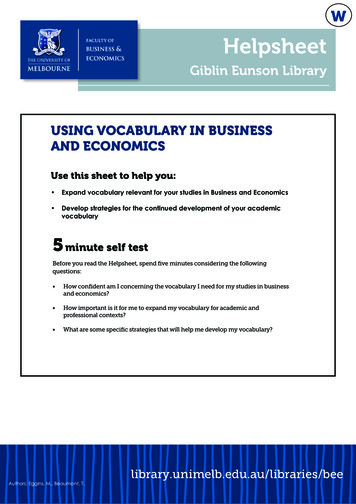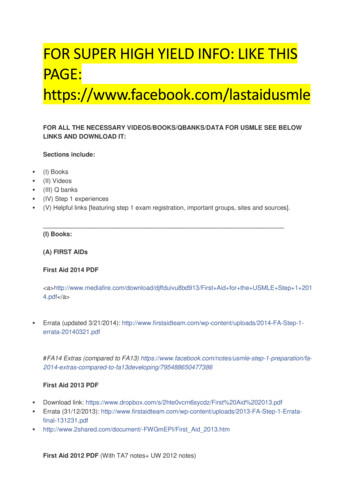
Transcription
Super-Economics Man!Using Superheroes to Teach EconomicsPeople the world over are familiar with comic book heroes. These characters have been portrayed on pages, television and movie screens and even in song for decades. Comic storylineschange as time marches on keeping them remarkably current, and characters are relaunchedregularly so new readers can continually jump into the action. This heretofore untapped genrewith extensive character development and complex plots is full of economic content. Usingsuperheroes to illustrate economic concepts expands the educator’s tool bag for students inthe K-12 space but certainly applies to undergraduates in a variety of classes as well. This paperwill use superheroes to discuss several different topics including scarcity, opportunity costs,specialization, public goods, moral hazard, production functions, and utility.Brian O’Roark††Robert Morris University 2017 Journal of Economics Teaching. All rights reserved.
O’Roark / Journal of Economics Teaching (2017)1. IntroductionSuperheroes have undergone a renaissance since 2000 when the first X-Men movie premiered.1 Movies showcasing Batman, Superman and Spiderman, along with slightly less prominent personas such as Ironman, Captain America, Ant Man and Dr. Strange have raked in tens ofbillions of dollars. According to the Motion Picture Association of America, since 2013, at leastone film featuring comic book characters has been in the year’s top three box office earners,and in 2013, and 2014, Iron Man 3, and Guardians of the Galaxy were the top earning movies(Motion Picture Association of America, 2014; 2015). Television shows based on superheroes,both live action and animated, are watched by millions on a weekly basis. These characters,born from humble comic book origins, have fired imaginations, sparked industries and generated legions of fans, many of whom are in the high school- and college-age demographic.Graphic Policy, a website devoted to the comic industry, provides monthly demographics oncomic fans collected through Facebook. Collecting data on users who “like” comics or graphicnovels yielded a sample of 36 million users, nine million of whom were 21 years old or younger.Another nine million were between the ages of 22 and 25. Of these, the gender breakdownwas 59 percent male and 41 percent female. Fifteen million likes came from college graduates,and another 2.2 million from currently enrolled college students (Schenker, 2016).2 Boopsie,a mobile platform developer for libraries, reporting on the holdings of public libraries, foundthat 98 percent of public libraries have graphic novels or comics in their collections (Boopsie,Inc., 2017). Of these libraries, 67 percent state that their acquisition of these materials came asa result of patron demand, and 54 percent of borrowers of these materials were between theages of 10 and 18. As a further signal of the popularity of comics, the annual ComicCon comicand science fiction convention in San Diego, California, which in 2000 sold 50,000 passes, nowregularly sells out more than 130,000 passes in hours and is the largest convention in San Diegoevery year. In short, superheroes are big business and among those following some manifestation of the genre are our students.While much of what happens in superhero storylines is predictable, the path of the superhero is filled with choices, trade-offs and strategies. Add to this the richness of the hundreds ofcharacters who fill the pages of comics and the celluloid of video and you have fertile groundfor teaching economics. The objective of the paper is not necessarily to explain the behavior ofheroes or villains, although that sometimes flows out of the analysis. Rather, the goal is to illustrate how economic concepts are related to the culture outside the classroom. This paper willexplore how superhero stories address basic concepts like scarcity, specialization and opportunity cost, along with more advanced notions of public goods, production functions, and utility.A practical question is into whose classroom do superheroes fit? Comics are typically labelled as juvenile. As such, the assumption that they would only appeal to a K-12 curriculumis understandable. However, based on the demographics noted earlier, the college-age population is a large part of the superhero fan base, and as fans they are quick to warm up to theseexamples making them compatible with principles classes as well.1 Though some might go back as far as 1989 when the relaunch of the Batman franchise began, the premiere of the X-Menlaunched a small frenzy of superhero based films. In 2002, Spiderman appeared in theaters followed in 2003 by Daredevil, theHulk, and a second X-Men movie.2 Due to parental limitations, it is presumed that those under the age of 16 are underrepresented in Facebook data.
O’Roark / Journal of Economics Teaching (2017)2. Literature ReviewAdvocates for expanding the teaching tool bag, notably Becker (2000), Tinari and Khandke(2000), and Watts and Becker (2008) have implored the discipline to teach outside the constraints of chalk and talk and some have heeded the call. A rich literature has evolved showinghow movies and television clips can be a useful tool for educators. Leet and Houser (2003), Mateer (2005), Sexton (2006), Mateer and Li (2008), Moulder (2009), Mixon (2010), Luccasson andThomas (2010), Mateer, Ghent, and Stone (2011), Ghent, Grant, and Lesica (2011), Mateer andStephenson (2011), Mateer, O’Roark, and Holder (2016), and Tierney, Mateer, Smith, Wooten,and Geerling (2016) provide pedagogical approaches and examples that integrate video mediainto the economics classroom.The written word has a lot to offer as well. Some authors have taken to the supernatural.Wight’s (2002) novel Saving Adam Smith, imagines how the spirit of Smith would view themodern world both in terms of economics and ethics. Miller and Felton (2002) provide examples of economic ideas in Greek mythology. Their focus is on how theories of truth inducementand separating equilibrium are used to teach game theory. As the authors note, students “finda good story far more interesting than an elegant theorem” (p. 77). This perspective seemsto be particularly relevant in the efforts of others. One of the more ingenious applications ofeconomics in fiction is Rockoff’s (1990) evaluation of The Wizard of Oz as an allegory of bimetallism.3 More recently, Deyo and Podemska-Mikluch (2013) have applied economic thinking tothe world of Harry Potter.Not to be left out, dystopian stories have been used to show the connection between economics and literature. Cleveland, Holder, and O’Roark (2016) turned to The Hunger Gamesto illustrate how a series of economic concepts including production possibilities, comparative advantage, the role of institutions, and income inequality, are part of this post-apocalypticworld. Roback (1985), Resch (1997), and Hamlen (2000) focus on the dystopian works of Orwell,zeroing in on the role of government and the free market, or lack thereof. Raj and Prayer (2012),calling Dickens’ Hard Times a dystopian novel, explains the failures of Utilitarian philosophy.Particularly relevant to this discussion of superheroes, Luccasson, Hammock, and Thomas(2011) examine the impact of cartoons in the classroom. They use four cartoon shows to illustrate concepts in principles of macroeconomics. In another cartoon-based analysis, Millerand Watts (2011) focus on the economics in Dr. Seuss stories. One of the more popular uses ofcartoons to illustrate academic ideas is the wide-ranging dependency on The Simpsons. Thiscartoon family has been used to teach psychology (Brown & Logan, 2006), physics (Halpern,2007) and religion (Pinsky, 2001) as well as economics (Hall, 2014).One of the advantages of characters like those in The Simpsons and Dr. Seuss, is the greatfamiliarity bred by longevity. Superheroes are much longer lived than Homer Simpson and hisfamily, and more well-known world-wide than Dr. Seuss, making it surprising that no one haswritten about how to use them in a class. Familiarity with characters and conditions means agreater likelihood of connecting with students. This is the problem with some of the researchin this review. Eventually shows are cancelled and fade from memory and some movies areno longer watched by younger viewers. Similarly, books become dated. The benefit of superheroes is that they live on, changing as the culture changes, making them a durable tool forteaching.3While Hansen (2002) disputes Rockoff’s position claiming L. Frank Baum, author of The Wizard of Oz, was not sympatheticto populist themes, the economic link to The Wizard of Oz is an alluring one.
O’Roark / Journal of Economics Teaching (2017)3. The Superhero WorldSummarizing the superhero world in any detail would require far more space than will begiven here. For instance, characters are regularly rebooted resulting in multiple storylines formajor characters. Some heroes are killed off or lost to alternative dimensions to be replaced bysome other incarnation.4 The good guys don’t always remain that way (don’t bring up Hal Jordan – the Green Lantern – turning evil with a fan5), and neither do villains (Lex Luthor joined theJustice League in a 2014 story arc6). Nevertheless, there are some aspects that must be clearlyestablished to set the stage for understanding the economics inherent in superhero stories.The superhero type of comic book began in 1938 with the appearance of Superman in Action Comics #1. Prior to this the Shadow provided a masked man and Flash Gordon displayedextreme courage fighting battles in outer space, but the “Man of Steel” trumped them with hissuperhuman ability. It is here where a critical division within the superhero world develops.One group of superheroes possess skills acquired as a result of a change in their physical nature.Some heroes have alien origins, others are demi-gods, while others gained their powers froma science experiment gone wrong. The other group of heroes are decidedly human. Typicallyrich with limitless funds, they experience some tragedy in their lives and subsequently developa specific skill set or adopt a futuristic technology. Matched with uncanny intellect, they defendthose unable to defend themselves. Table 1 contains a list of some of the heroes who fall intoeach category.Despite the intricacy of the superhero oeuvre, most stories center on the theme of goodversus evil. Consider the primary job of a superhero. They are there to protect those weakerthan themselves. The big-name heroes have a clear-cut purpose summed up in a motto Superman is out to defend “truth, justice and the American way.” Spiderman knows that “with greatpower comes great responsibility.” Batman is more loquacious, saying “I made a promise on thegrave of my parents that I would rid this city of the evil that took their lives. By day, I am BruceWayne, billionaire philanthropist. At night, criminals, a cowardly and superstitious lot, call me.Batman.” The X-Men are more direct. They are “sworn to protect a world that hates and fearsthem.” Superheroes are part of a system that was a scary place at the time of their conception,the late 1930s through the 1940s. They were created to bring order and protect the law abiding. In essence, they exist to defend life, liberty and property. Yet, they do so in an outsized anddramatic way.With this short primer, let’s begin looking at how these fictional creations can be used toteach economics; but first, a word of caution is in order. Using these characters in class mayseem daunting. If you aren’t a comic book aficionado, or you have students who are immersedin the genre, they might call you out on some minor details or bog the class down with questions. Therefore, it is recommended that you use these ideas with restraint. General applicationis better than specific, unless you really know your stuff. That being said, even a rudimentaryknowledge of the superhero world can provide excellent examples and enliven your classes.4For example, there have been at least three characters to take the name “The Flash,” along with a couple of kid Flashes, areverse Flash and a lady Flash.5 See “Green Lantern: Emerald Twilight,” (Marz, 1994), Green Lantern, Volume 3, Numbers 48-50 as a starting point.6 See “Justice League: Injustice League,” (Johns, 2014), Justice League, Volume 1, Numbers 30-39.
O’Roark / Journal of Economics Teaching (2017)Table 1 – Superhero ClassificationsSupernatural SuperheroesALIEN: Hawkgirl Martian Manhunter Silver Surfer SupermanEXPERIMENT: Captain America Dr. Manhattan The Fantastic Four Flash Hulk Sentry SpidermanGODS: Thor Wonder WomanMAGIC: Captain Marvel Dr. StrangeMUTANT: Aquaman Black Bolt Colossus Deadpool Scarlet Witch Wolverine X-MenHuman Capital Heroes Ant Man Batman Green Arrow Green Hornet Green Lantern Iron Man Nightwing The Punisher
O’Roark / Journal of Economics Teaching (2017)4. Economic TopicsBefore getting to the topics, it might be useful to understand how these examples can beimplemented. There are, of course, multiple ways to do this and I have provided a list of locations for material discussed below in Appendix A. Film clips can be used prior to or after theintroduction of a topic to illustrate ideas and provide a launching point for discussions. A briefintroduction to the topic might be useful so that students know what they are looking for. Using the clips after presenting the topic can be coupled with a question asking students to notehow a concept was displayed in a scene. Another option would be to have students watch aclip outside of class and come prepared with suggestions of the economic concepts that appear in the video.Copies of scenes from comic books are also good sources of content. Particular scenes canillustrate concepts extremely well and a Google search will often provide you with a renderingof a comic book page. The useful sit
Movies showcasing Batman, Superman and Spiderman, along with slightly less promi - nent personas such as Ironman, Captain America, Ant Man and Dr. Strange have raked in tens of billions of dollars. According to the Motion Picture Association of America, since 2013, at least one film featuring comic book characters has been in the year’s top three box office earners, and in 2013, and 2014 .











